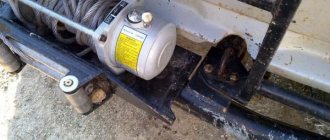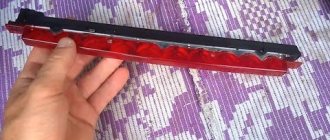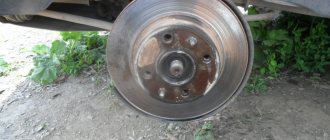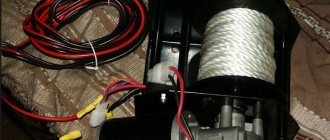Many SUV owners have at least once thought about installing a winch on their vehicle. It’s understandable; this useful device will help you pull your car out from anywhere. But installing a winch, say, on a UAZ is not so easy; Not only does it cost quite a lot, but it also requires a special space for installation, which is usually provided in the power bumper. Again, you will have to spend money on a power bumper. You can, of course, save money and make a power bumper and even a winch with your own hands, but this requires special equipment, certain skills and time. A good alternative to a winch is a self-puller.
What is a self-extractor?
A self-puller is, in fact, the simplest winch for a wheel. It is attached to the wheel hub using bolts or some other means. After this, a cable is wound around it, the other end of which is securely tied to the tree. The self-puller rotates along with the slipping wheel, wraps the cable around itself and thus pulls the car out of the mud.
Self-extractor for UAZ
Typically, the self-extractor is attached not to one wheel, but to two on the same axle. One end of the cable is attached to one wheel, the other to the other. The middle is passed through a block, which is attached to a tree or other reliable object. This ensures uniform winding of the cable and smooth movement. In addition, on conventional axles with an unlocked differential, installing a self-puller on one wheel is useless, because the device will simply block it, and the opposite wheel will slip in place.
You can also run the cable not directly, but through a system of blocks on the bumper so that the cable comes out from the center of the bumper, although this solution has dubious advantages. If possible, such a simple homemade winch should be installed on the wheels of the rear axle, because When installed on the front axle there is a risk of bending the steering rods.
Where to buy a self-extractor?
You can usually purchase this simple device by looking at ads on the Internet. Most of them are homemade and cost less than 1000 or even 500 rubles. In addition, you can make a self-puller with your own hands or order it from a local craftsman. This does not require any specific skills or tools. Drawings can be found on the Internet, or you can do without them altogether, because... The self-extractor device is incredibly simple.
The design of the self-extractor is very simple
How to make a wheel-mounted winch
A homemade winch works on the principle of a reel: when the cable is twisted, the car is pulled out of the swamp. The assembly of such a winch begins with the spool. Most often, craftsmen use a wheel rim whose diameter is slightly smaller than that of machine rims.
Before starting work, you should take a spare tire and attach a disc to it. After this, marks are made in the places where the wheel holes are located.
At the location of the marks, L-shaped steel hooks are welded, with the help of which it will be possible to engage the disc with the car wheel through the holes. It is not necessary to make hooks opposite each hole; one hole will be enough.
Beginners in this business are advised to first grab the pins a little, and finally scald only after fitting. For convenience, it is better to paint the finished product, because now it will always travel in a clean trunk.
Pros and cons of self-pullers
The attitude of SUV owners towards self-extractors is ambiguous. Some consider them to be a completely worthy replacement for a winch, while others, on the contrary, speak extremely negatively about these devices. Let's try to highlight the main pros and cons that a self-extractor for a UAZ or other SUV has.
So, the advantages:
- simplicity and reliability of design;
- low cost or ease of self-production;
- takes up little space in the trunk;
- does not require special fastening or professional installation;
- When used correctly, the traction force is limited only by the engine power.
Perhaps the device has other advantages. Now let’s list the obvious disadvantages of self-pullers:
- risk of damage to the vehicle (especially steering rods);
- limited functionality (the winch can be used for many other tasks besides pulling out a car);
- uneven winding of the cable;
- inconvenient to use (it’s easier to pull the car out with a winch).
The list may also not be complete; perhaps self-pullers have other disadvantages.
Manual
The structure of a car winch of this type is quite simple; most often the cable is wound on a drum or reel, through a system of sprockets of various sizes or a gearbox driven into rotation by muscle force. What such a device might look like can be seen in the photo below, recommendations for use in the video
Conclusion
In some cases, a self-retractor is quite capable of replacing a winch. Of course, if the car participates in competitions or is used on very difficult off-road conditions, where it needs to be pulled out of captivity every few minutes, then it is better to use a winch, and of considerable power. If the car is used for fishing, hunting or other rides on not very difficult off-road conditions, then a self-extractor is quite suitable. Of course, a winch is in most cases more convenient and preferable, but given its cost, it is not always available. A self-puller will cost a ridiculous amount, but it is quite capable of coping with tasks that are usually assigned to a winch.
Another design option
Such a multi-faceted winch
Such a device has many different modifications, differing primarily in the drive used. Among them it is worth noting the following winches:
- manual;
- hydraulic;
- mechanical;
- electric.
In addition to differences in the type of drive, winches differ in the method of installation and mounting on the vehicle:
- stationary;
- portable (removable);
- mobile.
The transmission of force may also be different. By this feature you can identify winches:
- with winding drums;
- with friction drums or pulleys.
It should be noted that the most common is the first of the classifications presented, so it will be possible to consider automobile winches of the types indicated there in more detail.
Homemade electric winch
If you have an unnecessary, fairly powerful electric drive, you can easily make an electric winch with your own hands from scrap materials.
To assemble such a unit, you need the following materials and tools:
- welding inverter;
- profiled (square) pipe for making a frame;
- ready-made or homemade shaft (can be made from a pipe);
- 2 gears of large and small diameters, matching teeth;
- chain for connecting gears;
- 6 nuts;
- 6 studs no longer than 24 cm, corresponding to the threads of the nuts;
- hubs;
- cable with carabiner;
- 12 V electric motor (power selected to suit your needs).
Note!
Do-it-yourself vibrating table - selection of materials, components and assemblies for a vibrating table with a step-by-step manufacturing descriptionDo-it-yourself grain crusher - operating principle, types and features of creating a device for processing grain crops
DIY concrete mixer | A visual aid on how and what to make a concrete mixer yourself
Note! You can turn on the car winch only when the engine is running, since it consumes a lot of electricity.
Manufacturing procedure:
- Installing discs on the cylinder. The distance is selected in accordance with the length of the cylinder (pipe) and cable.
- Installing the hubs and large gear onto the shaft. The hubs are responsible for reliable fixation of the drum.
- Installation of the small gear on the counter shaft and its connection to the large one via a chain.
In a similar way, you can build an electric plow with your own hands. The unit works according to the following principle: the winch is securely fixed on one side of the site, on the other side there is a plow connected to it by a cable. When the drive is turned on, the plow begins to move towards the winch, plowing the ground.
It is not advisable to use a 12 V electric motor at home or in a workshop. It is better to use a 220 V motor connected to a standard household electrical outlet.
Do-it-yourself winch - price
If you have your own garage or shed with rubbish accumulated over several years of home plumbing, the cost of the product is determined by the price of a can of spray paint for final finishing.
Basically, the components are as follows:
- Starter from a VAZ 2101 car without a planetary gearbox (working, lying in the garage);
- A gearbox in a housing from a domestically produced electric drill (purchased at a flea market for the equivalent of 0.5 vodka);
- A piece of water pipe found in a barn;
- Metal for the frame, body walls, drum. Also found in a barn;
- Drum axle - purchased at a scrap metal collection point for pennies;
- The rope and hook were purchased at a tourism supply store.
Taking into account the cost of a new winch, the cost of the issue can be considered zero. At the same time, the owner can vouch for the safety of the device. Every detail and weld is personally checked by the manufacturer.
Winch from a car starter
A DIY 12V electric winch is made from old car parts, a metal profile and is powered by a battery. A 12V car starter is used as an electric drive.
It is recommended to use a planetary gearbox. It can be removed from old VAZ cars or bought inexpensively in workshops that dismantle cars.
The following basic materials will be required:
- wires;
- cable (steel or polymer);
- gears;
- drum;
- starter;
- gearbox;
- profile pipes and steel sheet.
The winch from the starter is assembled with your own hands in the following sequence:
- Manufacturing of frames from profiles and sheet steel. The frame must be welded.
- Installing the drum into the seats. The drum is secured with bolted connections.
- Connecting the starter to the gearbox using adapters.
- Checking the alignment of the teeth of the input shaft with the gear. The parts must connect freely. Otherwise, you need to replace the shaft or gear.
- Installing the gear on the cylinder.
- Connecting electrical wiring.
This is not a high-power winch; you won’t be able to make a traction device for high loads from a starter yourself, which is due to the relatively low drive power. But, if you replace the starter with a more powerful electric motor, you can make a unit for moving heavy loads.
additional information
It is impossible not to separately touch upon several issues of using a winch. Firstly, it can be permanently attached to the car, most often at the front. However, in this case, its mechanism is exposed to dust, dirt, and moisture, which is not good for it. To avoid this, many drivers practice using a portable winch, which is usually stored in the trunk of the car and removed if necessary. Such a winch can be installed not only in front, but also in the rear of the car, such as in the photo below.
To do this, as a rule, you only need to install an additional platform on the bumper (front or rear), to which the winch is attached.
A few words must be said about how to connect to the battery. An electric winch is a powerful consumer of energy, and therefore, if it is frequently used off-road, it may very well become possible for the original “battery” to be completely discharged. To avoid this, in some cases it is worth considering an independent battery to power such a device.
Types of structures
What types of winches are there for cars? According to the most general classification, car winches are manual and automatic. The latter are also divided into mechanical and electrical.
Mechanical. This type of device operates thanks to the power of the engine of the car itself. Thus, the driver does not need to make any physical effort. At the same time, the main disadvantage of this type of design is that if the motor is not running, it will not function.
It is worth noting that in force majeure situations, car engines fail quite often, which makes such a winch absolutely useless. At the same time, this device has high power and can be installed even on large cars. That is why it is quite difficult to make it at home.
Electric. This type of winch is equipped with a portable electric motor. Thus, the functioning of the device is absolutely independent of the condition of the car’s engine or the physical strength of its driver. This device is powered by a car battery. In part, this makes the device dependent on its charge level. Despite the rather complex design, this type of winch is characterized by relatively high reliability.
Hydraulic. It is driven by an oil pump, and is considered the most complex of all the listed structures. Its design includes an oil tank and a pump, as well as a special drive. This type of installation is quite powerful, but not as reliable as an electric one.
Manual. The design of this type of automobile winches is highly reliable, but also requires physical effort from the driver during operation. On the other hand, making such a device at home is quite easy. A special lever can minimize the load when dragging a stuck car, but this will not make the task much easier.
It is best to use a hand winch in pairs: one person outside, pressing the lever, and the other sitting behind the wheel and smoothly squeezing the gas. It is worth noting that structures of this type are significantly inferior to the previous ones in load capacity (up to 1 ton).
Manufacturing instructions
The manufacture of the device in question takes a relatively small amount of time. The design consists of several blocks; a self-puller is also installed, but not always. The instructions for making a winch are as follows:
- The main mechanism is a Zhiguli starter. It is ideal for generating the required force. In addition, such a starter costs practically nothing.
At the top of the device being created, a retractor relay with power contacts is installed. They are required in case there is a high load.- In order for the winch to be compact, a gearbox from a small drill is selected. Finding this mechanism is quite simple, since there are a huge number of drills on the market with a burnt-out electric motor. There are no special requirements for the gearbox; the main thing is that it must be reliable and powerful.
- The gearbox shaft is paired with the mating part of the starter motor. For this purpose, the electric welding method is used, which allows you to obtain a high-quality and reliable permanent connection.
- Experts do not recommend installing dampers. This is due to the fact that the axle is always under heavy load during operation. The damping device used is in a closed position, so it may break.
- To increase the gear ratio, a starter with a planetary gearbox is used. The complexity of the design determines that adapting it to the task at hand is not as simple as the usual version.
- The gearbox housing must be firmly connected to the electric motor housing. To protect the winch from environmental influences, a special housing is created, preferably a split type. In many cases, it is recommended to create a split design, since from time to time it is necessary to carry out maintenance of the motor bearings and gear mechanism.
- The next step is to create the drum. It is on this that the cable will be wound. You can make a drum at home from a pipe that has a diameter of about 180 mm and a wall thickness of 2-3 mm. With a smaller wall thickness, the pipe can be severely deformed.
- To fix the cable on the drum, it must have cheeks. They are made simply: they are cut out of a steel plate, after which holes are created to accommodate the shaft. The cheeks are welded to the sides of the drum.
- A structural element of a decommissioned electrified valve is used as a power shaft. It is quite often used in the creation of oil pipelines. To transmit rotation, a pair of gears is installed.
- All used elements must be securely welded together. This is due to the fact that even a minor defect can lead to the appearance of a crack. Too high a load will cause the mechanism to fail at the most crucial moment.
- To attach the winch, a frame is created, the manufacture of which uses a channel and a steel plate with a thickness of at least 5 mm. The corner is attached from the bottom in order to make the structure more rigid.
- The side walls are made using sheet metal 3-5 mm thick. Thin sheets can become deformed when the cable is pulled too hard.
- The most important part of the structure is the fastening of the drum axis. It is to this that the high load will be transferred. To fix the axle, it is recommended to use bearings with podiums. They are highly resistant to mechanical stress. You can find such bearings in the workshops of abandoned factories or at scrap metal collection points. If ordinary bearings were found, then a cage is welded to the sides.
After completing all the above work, the structure should be brought into a suitable form. To do this, all seams are checked and sanded, rust is removed, and the metal is coated with protective paint.
Recommendations for use
For safe and long-term operation of homemade automobile winches, you should adhere to the following instructions:
- Any manipulations with the cable should be carried out only after the device mechanisms have been completely deactivated.
- Use structures only for their intended purpose.
- This device does not provide for vertical movement of objects.
- Do not handle the structure or its components without gloves.
- Before use, carefully check the fastening of the device and its components.
Creating certain types of car winches at home is not an easy task, but perseverance and careful implementation of all recommendations will help you create a reliable and effective design that will help you out more than once in difficult situations.
Republished by Blog Post Promoter











